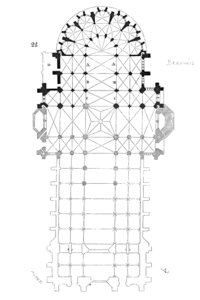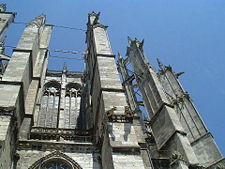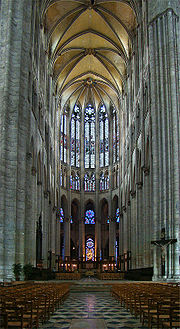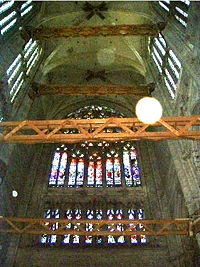
Cathédrale Saint-Pierre de Beauvais
Encyclopedia
The Cathedral of Saint Peter of Beauvais is an incomplete Roman Catholic cathedral
located in Beauvais
, in northern France
. It is the seat of the Bishop of Beauvais, Noyon and Senlis. It is, in some respects, the most daring achievement of Gothic architecture
, and consists only of a transept
(sixteenth-century) and choir, with apse
and seven polygonal apsidal chapels (thirteenth century), which are reached by an ambulatory
.
The small Romanesque
church of the tenth century, known as the Basse Œuvre, much restored, still occupies the site destined for the nave
.
 Work was begun in 1225 under count-bishop Miles de Nanteuil, immediately after the third in a series of fires in the old wooden-roofed basilica
Work was begun in 1225 under count-bishop Miles de Nanteuil, immediately after the third in a series of fires in the old wooden-roofed basilica
, which had reconsecrated its altar only three years before the fire; the choir was completed in 1272, in two campaigns, with an interval (1232–38) owing to a funding crisis provoked by a struggle with Louis IX
. The two campaigns are distinguishable by a slight shift in the axis of the work and by what Stephen Murray characterizes as "changes in stylistic handwriting." Under Bishop Guillaume de Grez, an extra 4.9 m was added to the height, to make it the highest-vaulted cathedral in Europe. The vaulting in the interior of the choir reaches 48 m in height, far surpassing the concurrently constructed Cathedral of Notre-Dame in Amiens
, with its 42 metres (137.8 ft) nave
.
The work was interrupted in 1284 by the collapse of some of the vaulting of the recently completed choir. This collapse is often seen as a disaster that produced a failure of nerve among the French masons working in Gothic style; modern historians have reservations about this deterministic view. Stephen Murray notes that the collapse also "ushers in the age of smaller structures associated with demographic decline, the Hundred Years War, and of the thirteenth century."
However, large-scale Gothic design continued, and the choir was rebuilt at the same height, albeit with more columns in the chevet and choir, converting the vaulting from quadripartite vaulting
to sexpartite vaulting. The transept was built from 1500 to 1548. In 1573, the fall of a too-ambitious 153-m central tower stopped work again. The tower would have made the church the second highest structure in the world at the time (after St. Olaf's church, Tallinn). Afterwards little structural addition was made.
The choir has always been wholeheartedly admired: Eugène Viollet-le-Duc
called the Beauvais choir "the Parthenon of French Gothic."
Its façade
s, especially that on the south, exhibit all the richness of the late Gothic style. The carved wooden doors of both the north and the south portals are masterpieces, respectively, of Gothic and Renaissance
workmanship. The church possesses an elaborate astronomical clock
in neo-Gothic taste (1866) and tapestries
of the 15th and 17th centuries, but its chief artistic treasures are stained glass windows of the 13th, 14th, and 16th centuries, the most beautiful of them from the hand of Renaissance artist Engrand Le Prince, a native of Beauvais. To him also is due some of the stained glass in St-Etienne, the second church of the town, and an interesting example of the transition stage between the Gothic and the Renaissance styles.
During the Middle Ages
, on January 14, the Feast of Asses was annually celebrated in Beauvais cathedral, in commemoration of the Flight into Egypt
.
In the race to build the tallest cathedral in the 13th century, the builders of Saint-Pierre de Beauvais pushed the technology to the limits. Even though the structure was to be taller, the buttresses were made thinner in order to pass maximum light into the cathedral. In 1284, only twelve years after completion, part of the choir vault collapsed, along with a few flying buttresses. It is now believed that the collapse was caused by resonant vibrations caused by high winds.
The accompanying photograph shows lateral iron supports between the flying buttress
es; it is not known when these external tie rods were installed. The technology would have been available at the time of the initial construction, but the extra support might not have been considered necessary until after the collapse in 1284, or even later. In the 1960s, the tie rods were removed; the thinking was that they were disgraceful and unnecessary. However, the oscillations created by the wind became amplified, and the choir partially disassociated itself from the transept. Subsequently, the tie rods were reinstalled, but this time with rods made of steel. Since steel is less supple than iron, the structure became more rigid, possibly causing additional fissures.
As the floor plan shows, the original design included a nave that was never built. Thus, the absence of shouldering support that would have been contributed by the nave contributes to the structural weakness of the cathedral.
With the passage of time, other problems surfaced, some requiring more drastic remedies. The north transept now has four large wood and steel lateral trusses at different heights, installed during the 1990s to keep the transept from collapsing (see photograph). In addition, the main floor of the transept is interrupted by a much larger brace that rises out of the floor at a 45-degree angle. This brace was installed as an emergency measure to give additional support to the pillars that, until now, have held up the tallest vault in the world.
These temporary measures will remain in place until more permanent solutions can be determined. Various studies are under way to determine with more assurance what can be done to preserve the structure. Columbia University is performing a study on a three-dimensional model constructed using laser scans of the building in an attempt to determine the weaknesses in the building and remedies.
windows made during the 13th through 15th centuries. In a chapel close to the northern entrance, there is a medieval clock (14th - 15th century), probably the oldest fully preserved and functioning mechanical clock in Europe. In its vicinity, a highly complicated astronomical clock
with moving figures was installed in 1866.
Cathedral
A cathedral is a Christian church that contains the seat of a bishop...
located in Beauvais
Beauvais
Beauvais is a city approximately by highway north of central Paris, in the northern French region of Picardie. It currently has a population of over 60,000 inhabitants.- History :...
, in northern France
France
The French Republic , The French Republic , The French Republic , (commonly known as France , is a unitary semi-presidential republic in Western Europe with several overseas territories and islands located on other continents and in the Indian, Pacific, and Atlantic oceans. Metropolitan France...
. It is the seat of the Bishop of Beauvais, Noyon and Senlis. It is, in some respects, the most daring achievement of Gothic architecture
Gothic architecture
Gothic architecture is a style of architecture that flourished during the high and late medieval period. It evolved from Romanesque architecture and was succeeded by Renaissance architecture....
, and consists only of a transept
Transept
For the periodical go to The Transept.A transept is a transverse section, of any building, which lies across the main body of the building. In Christian churches, a transept is an area set crosswise to the nave in a cruciform building in Romanesque and Gothic Christian church architecture...
(sixteenth-century) and choir, with apse
Apse
In architecture, the apse is a semicircular recess covered with a hemispherical vault or semi-dome...
and seven polygonal apsidal chapels (thirteenth century), which are reached by an ambulatory
Ambulatory
The ambulatory is the covered passage around a cloister. The term is sometimes applied to the procession way around the east end of a cathedral or large church and behind the high altar....
.
The small Romanesque
Romanesque architecture
Romanesque architecture is an architectural style of Medieval Europe characterised by semi-circular arches. There is no consensus for the beginning date of the Romanesque architecture, with proposals ranging from the 6th to the 10th century. It developed in the 12th century into the Gothic style,...
church of the tenth century, known as the Basse Œuvre, much restored, still occupies the site destined for the nave
Nave
In Romanesque and Gothic Christian abbey, cathedral basilica and church architecture, the nave is the central approach to the high altar, the main body of the church. "Nave" was probably suggested by the keel shape of its vaulting...
.
History

Basilica
The Latin word basilica , was originally used to describe a Roman public building, usually located in the forum of a Roman town. Public basilicas began to appear in Hellenistic cities in the 2nd century BC.The term was also applied to buildings used for religious purposes...
, which had reconsecrated its altar only three years before the fire; the choir was completed in 1272, in two campaigns, with an interval (1232–38) owing to a funding crisis provoked by a struggle with Louis IX
Louis IX of France
Louis IX , commonly Saint Louis, was King of France from 1226 until his death. He was also styled Louis II, Count of Artois from 1226 to 1237. Born at Poissy, near Paris, he was an eighth-generation descendant of Hugh Capet, and thus a member of the House of Capet, and the son of Louis VIII and...
. The two campaigns are distinguishable by a slight shift in the axis of the work and by what Stephen Murray characterizes as "changes in stylistic handwriting." Under Bishop Guillaume de Grez, an extra 4.9 m was added to the height, to make it the highest-vaulted cathedral in Europe. The vaulting in the interior of the choir reaches 48 m in height, far surpassing the concurrently constructed Cathedral of Notre-Dame in Amiens
Amiens Cathedral
The Cathedral of Our Lady of Amiens , or simply Amiens Cathedral, is a Roman Catholic cathedral and seat of the Bishop of Amiens...
, with its 42 metres (137.8 ft) nave
Nave
In Romanesque and Gothic Christian abbey, cathedral basilica and church architecture, the nave is the central approach to the high altar, the main body of the church. "Nave" was probably suggested by the keel shape of its vaulting...
.
The work was interrupted in 1284 by the collapse of some of the vaulting of the recently completed choir. This collapse is often seen as a disaster that produced a failure of nerve among the French masons working in Gothic style; modern historians have reservations about this deterministic view. Stephen Murray notes that the collapse also "ushers in the age of smaller structures associated with demographic decline, the Hundred Years War, and of the thirteenth century."
However, large-scale Gothic design continued, and the choir was rebuilt at the same height, albeit with more columns in the chevet and choir, converting the vaulting from quadripartite vaulting
Rib vault
The intersection of two or three barrel vaults produces a rib vault or ribbed vault when they are edged with an armature of piped masonry often carved in decorative patterns; compare groin vault, an older form of vault construction...
to sexpartite vaulting. The transept was built from 1500 to 1548. In 1573, the fall of a too-ambitious 153-m central tower stopped work again. The tower would have made the church the second highest structure in the world at the time (after St. Olaf's church, Tallinn). Afterwards little structural addition was made.
The choir has always been wholeheartedly admired: Eugène Viollet-le-Duc
Eugène Viollet-le-Duc
Eugène Emmanuel Viollet-le-Duc was a French architect and theorist, famous for his interpretive "restorations" of medieval buildings. Born in Paris, he was a major Gothic Revival architect.-Early years:...
called the Beauvais choir "the Parthenon of French Gothic."
Its façade
Facade
A facade or façade is generally one exterior side of a building, usually, but not always, the front. The word comes from the French language, literally meaning "frontage" or "face"....
s, especially that on the south, exhibit all the richness of the late Gothic style. The carved wooden doors of both the north and the south portals are masterpieces, respectively, of Gothic and Renaissance
Renaissance
The Renaissance was a cultural movement that spanned roughly the 14th to the 17th century, beginning in Italy in the Late Middle Ages and later spreading to the rest of Europe. The term is also used more loosely to refer to the historical era, but since the changes of the Renaissance were not...
workmanship. The church possesses an elaborate astronomical clock
Astronomical clock
An astronomical clock is a clock with special mechanisms and dials to display astronomical information, such as the relative positions of the sun, moon, zodiacal constellations, and sometimes major planets.-Definition:...
in neo-Gothic taste (1866) and tapestries
Tapestry
Tapestry is a form of textile art, traditionally woven on a vertical loom, however it can also be woven on a floor loom as well. It is composed of two sets of interlaced threads, those running parallel to the length and those parallel to the width ; the warp threads are set up under tension on a...
of the 15th and 17th centuries, but its chief artistic treasures are stained glass windows of the 13th, 14th, and 16th centuries, the most beautiful of them from the hand of Renaissance artist Engrand Le Prince, a native of Beauvais. To him also is due some of the stained glass in St-Etienne, the second church of the town, and an interesting example of the transition stage between the Gothic and the Renaissance styles.
During the Middle Ages
Middle Ages
The Middle Ages is a periodization of European history from the 5th century to the 15th century. The Middle Ages follows the fall of the Western Roman Empire in 476 and precedes the Early Modern Era. It is the middle period of a three-period division of Western history: Classic, Medieval and Modern...
, on January 14, the Feast of Asses was annually celebrated in Beauvais cathedral, in commemoration of the Flight into Egypt
Flight into Egypt
The flight into Egypt is a biblical event described in the Gospel of Matthew , in which Joseph fled to Egypt with his wife Mary and infant son Jesus after a visit by Magi because they learn that King Herod intends to kill the infants of that area...
.
Structural condition
 |
 |
In the race to build the tallest cathedral in the 13th century, the builders of Saint-Pierre de Beauvais pushed the technology to the limits. Even though the structure was to be taller, the buttresses were made thinner in order to pass maximum light into the cathedral. In 1284, only twelve years after completion, part of the choir vault collapsed, along with a few flying buttresses. It is now believed that the collapse was caused by resonant vibrations caused by high winds.
The accompanying photograph shows lateral iron supports between the flying buttress
Flying buttress
A flying buttress is a specific form of buttressing most strongly associated with Gothic church architecture. The purpose of any buttress is to resist the lateral forces pushing a wall outwards by redirecting them to the ground...
es; it is not known when these external tie rods were installed. The technology would have been available at the time of the initial construction, but the extra support might not have been considered necessary until after the collapse in 1284, or even later. In the 1960s, the tie rods were removed; the thinking was that they were disgraceful and unnecessary. However, the oscillations created by the wind became amplified, and the choir partially disassociated itself from the transept. Subsequently, the tie rods were reinstalled, but this time with rods made of steel. Since steel is less supple than iron, the structure became more rigid, possibly causing additional fissures.
As the floor plan shows, the original design included a nave that was never built. Thus, the absence of shouldering support that would have been contributed by the nave contributes to the structural weakness of the cathedral.
With the passage of time, other problems surfaced, some requiring more drastic remedies. The north transept now has four large wood and steel lateral trusses at different heights, installed during the 1990s to keep the transept from collapsing (see photograph). In addition, the main floor of the transept is interrupted by a much larger brace that rises out of the floor at a 45-degree angle. This brace was installed as an emergency measure to give additional support to the pillars that, until now, have held up the tallest vault in the world.
These temporary measures will remain in place until more permanent solutions can be determined. Various studies are under way to determine with more assurance what can be done to preserve the structure. Columbia University is performing a study on a three-dimensional model constructed using laser scans of the building in an attempt to determine the weaknesses in the building and remedies.
Interior
Several of the chapels contain medieval stained glassStained glass
The term stained glass can refer to coloured glass as a material or to works produced from it. Throughout its thousand-year history, the term has been applied almost exclusively to the windows of churches and other significant buildings...
windows made during the 13th through 15th centuries. In a chapel close to the northern entrance, there is a medieval clock (14th - 15th century), probably the oldest fully preserved and functioning mechanical clock in Europe. In its vicinity, a highly complicated astronomical clock
Astronomical clock
An astronomical clock is a clock with special mechanisms and dials to display astronomical information, such as the relative positions of the sun, moon, zodiacal constellations, and sometimes major planets.-Definition:...
with moving figures was installed in 1866.
 |
 |
External links
- Cathedral of Beauvais Digital Media Archive (creative commonsCreative CommonsCreative Commons is a non-profit organization headquartered in Mountain View, California, United States devoted to expanding the range of creative works available for others to build upon legally and to share. The organization has released several copyright-licenses known as Creative Commons...
-licensed photos, laser scans, panoramas), data from a World Monuments FundWorld Monuments FundWorld Monuments Fund is a private, international, non-profit organization dedicated to the preservation of historic architecture and cultural heritage sites around the world through fieldwork, advocacy, grantmaking, education, and training....
/CyArkCyArkCyArk is a 501 nonprofit organization located in Oakland, California, United States. The company's website refers to it as a "digital archive of the world’s heritage sites for preservation and education"...
research partnership - 360 degrees panorama virtual tour of some French cathedrals including Beauvais
- Photographs and drawings of the cathedral
- Spectacular views of the inside

